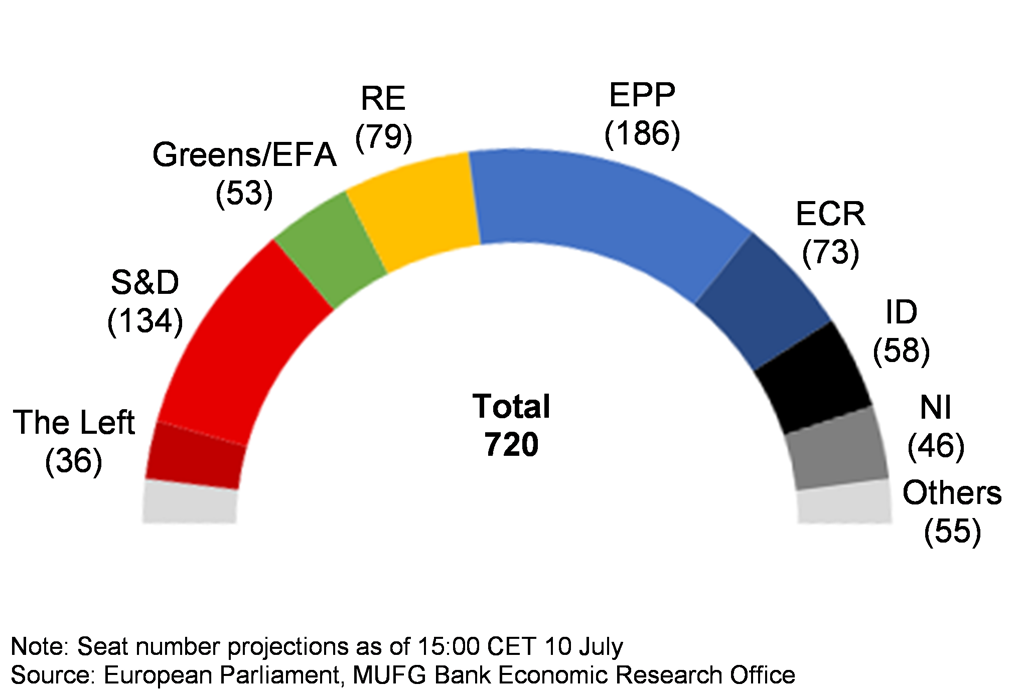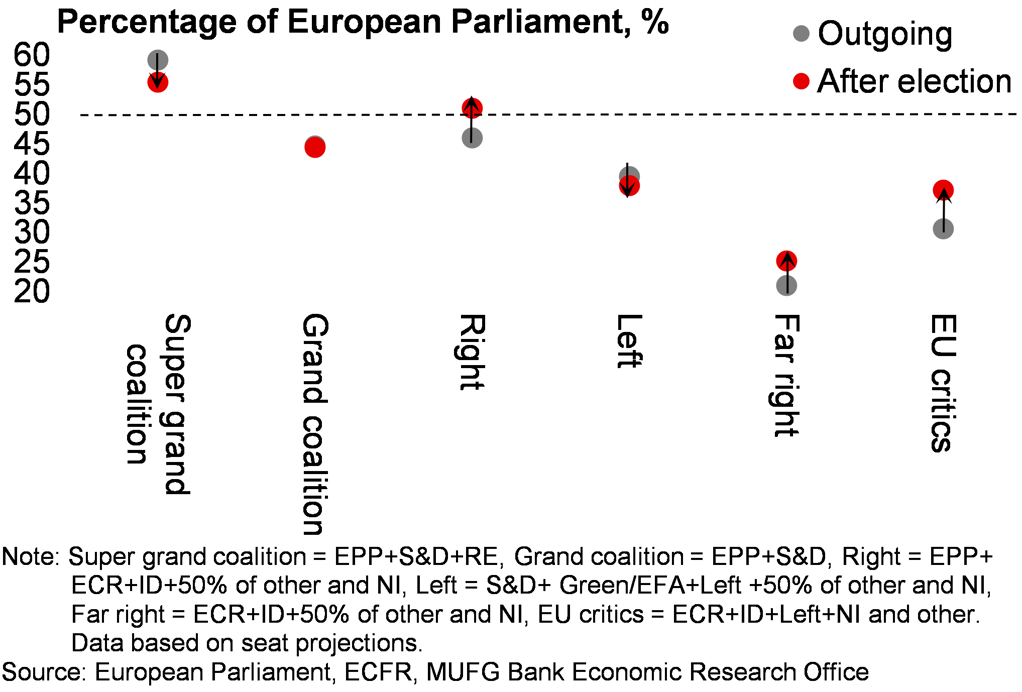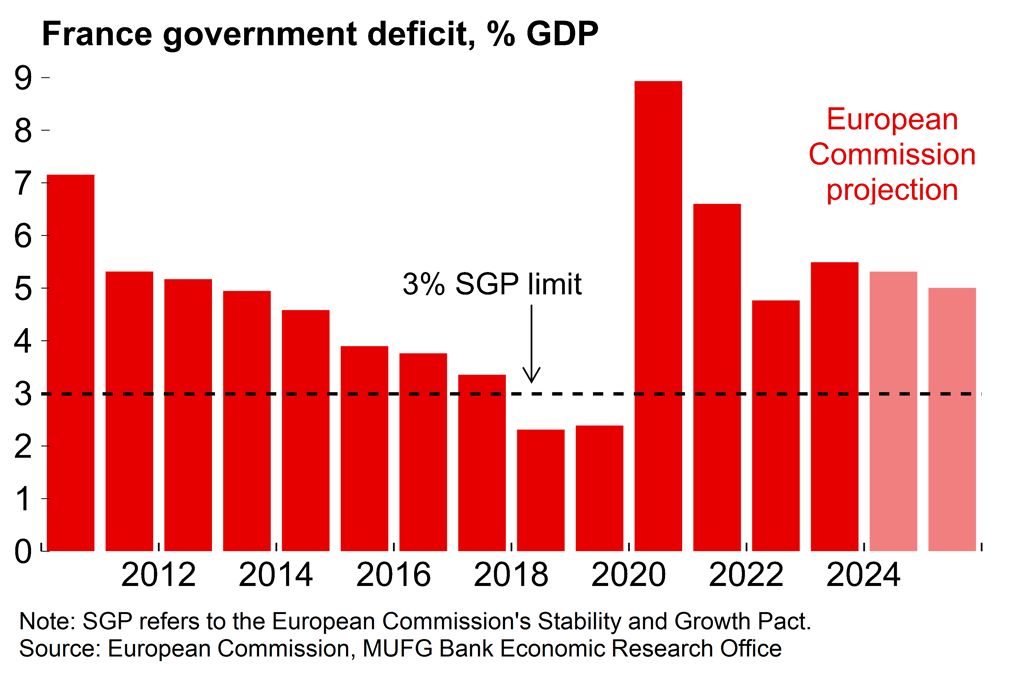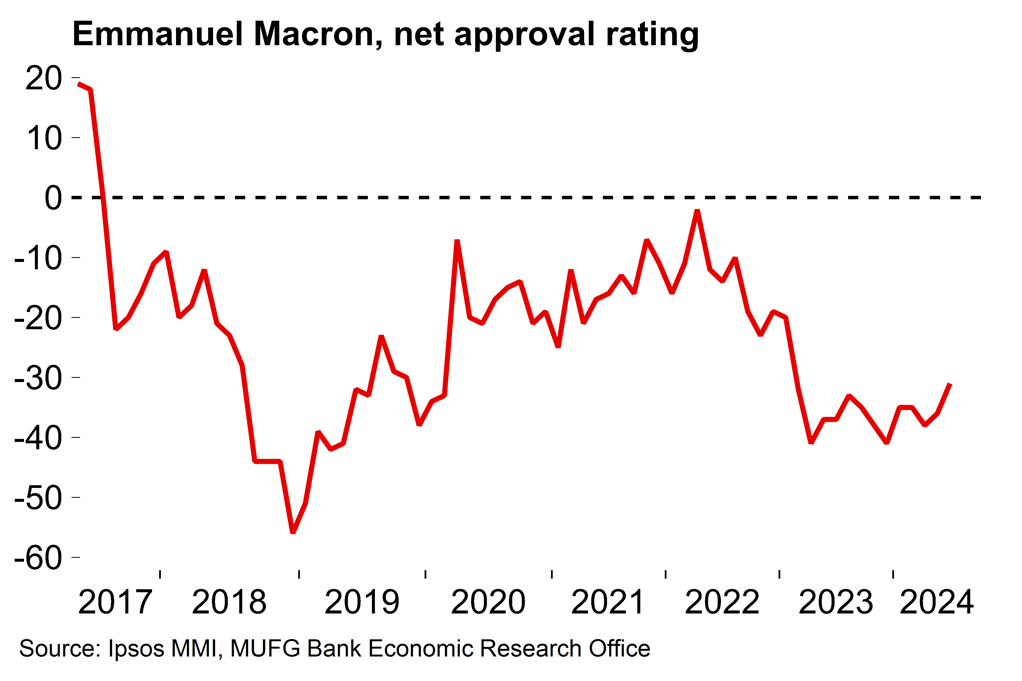France leads a shift to the right in the EU parliament election
- Far-right parties have increased their share of seats from around a fifth in 2019 to a quarter following last week’s European Parliament elections, broadly in line with expectations. While some moderate groups lost ground, the centre remains broadly intact with the EPP remaining the largest group. There are some risks of a more fractured parliament with increased pressure on centrist groups to gain support from the far right and other smaller groups.
- The result in France was most consequential with president Macron moved to call a snap legislative election in just three weeks’ time. This appears to be a huge gamble with his group trailing well behind the populist right wing Rassemblement Nationale (RN) party led by Marine Le Pen, raising European political risks.
To read the full report, please download the PDF above.
The European Parliament shifts to the right – but the centre remains intact
The results of the European Parliament elections (Chart 1) were broadly in line with the polling projections: the centre-right European People’s Party (EPP) remains the largest group and right-wing groups European Conservatives and Reformists (ECR) and Identity and Democracy (ID) saw a rise in votes from 2019. The biggest losers were the liberal centrists Renew Europe (RE) and the Greens which each lost a significant share of the vote (Chart 2).
Despite some projections for a surge in support for far-right parties, the pro-European centre ultimately held firm. The ‘super grand coalition’ of moderate, centrist parties slipped back slightly (from 56% to 59% of seats) due to losses for the centre-left Socialist and Democracy group (S&D) and RE, but still commands a majority. With the EPP remaining the largest party, Ursula von der Leyen is seemingly well-placed at this stage for another term as president of the European Commission, which would mean continuity and stability. The EPP ultimately tightened its grip on the European Parliament as the centre-left S&D and liberal RE slipped back. We expect these three parties will continue to co-operate and remain the most influential groups in terms of EU policy, especially regarding the budget and economy.
Nonetheless, the results do point to a more fractured parliament. There is a possibility that the traditional, mainstream groups will have to rely on smaller groups on occasion – including those on the far right – when voting on certain issues. As the ‘cordon sanitaire’ that existed around parties on the hard right continues to gradually weaken, members of ECR and ID are set to have a greater influence on creation of legislation and on the broader political debate. That said, it should be noted that voting cohesion between far-right groups has historically been comparatively low. The lack of unity was reflected in the pre-election group manifestos: extremely short (in the case of ECR) or non-existent (in the case of ID). The Alternative for Germany party was ejected from the latter group two weeks before the elections in another sign of fragmentation.
More broadly, the result provided further evidence of the shift towards right-wing and Eurosceptic nationalist parties that has occurred in Europe in recent years on the back of dissatisfaction among voters towards mainstream parties over their response to issues such as the pandemic, migration, higher energy prices and broader inflationary pressures. Whether or not there will be a reversal in voting patterns over coming years (the near-term macro outlook appears to be quite benign in Europe) remains to be seen following the ongoing normalisation of what were once viewed as radical parties.
Chart 1: The new composition of the European Parliament

Chart 2: The change in seats has resulted in a smaller left wing and a rise in the far right

The election has had a more significant impact on national politics
Our broad view is that the new configuration of the European Parliament is unlikely to present many significant new obstacles to the legislation process. However, European Parliament election results often take on more significance at a national level – and the most consequential result by far was seen in France.
The populist right wing Rassemblement Nationale (RN) party, led by Marine Le Pen, was the clear winner of the election in France with 31% of the vote – winning more than twice that of the list led by President Macron’s Rennaissance party (14%). In response, Macron made the surprise move of immediately calling a snap legislative election in an attempt to seize the initiative and wrong-foot his opponents. The first round will be held in just three weeks’ time, on 30 June, with the second round on 7 July.
The lack of detailed polling at this stage and the two-round system (which means allegiances can be formed between votes) makes it hard to predict the outcome of the election. Macron will want to show that support for RN was driven by protest votes rather than a desire to see the party in government at a national level. With the left fragmented and the traditional right neutered, Macron will also hope to mobilise anti-RN voters.
If Macron’s party were to perform well it would restore some legitimacy to a government that would have some difficult decisions to take over coming months. Fiscal consolidation is required in France to trim a budget deficit which easily exceeds the European Commission’s 3% limit (Chart 3). This has left the country on the brink of being placed under an Excessive Deficit Procedure by the Commission which will require a plan for corrective action.
Nonetheless, it’s a huge gamble. Macron’s approval ratings remain low (Chart 4), while RN increased its vote share by 10pp in this European election. Le Pen has made efforts to sanitise her party’s image in recent years and will be buoyed by the success of Giorgia Meloni using a similar approach to become PM in Italy. A RN-led government during Macron’s last years of presidency would likely result in several years of policy inertia at a time when the French economy is facing lacklustre growth (MUFG: 0.8% in 2024).
If RN were to perform strongly in the upcoming elections, the party would seek to use the result as a springboard for victory in the 2027 presidential election. RN is Eurosceptic and has been strongly critical of NATO, and a Le Pen presidency would likely have far-reaching consequences for the EU and Ukraine, as well as France.
While France is clearly the focus there were also some notable shifts in support seen in other countries, with the centre ground holding in some member states but giving way to the right in others. The table in the PDF version (see link above) shows a brief summary of the election results in major EU countries.
Chart 3: The French budget deficit widened in 2023

Chart 4: Macron’s personal approval ratings remain weak



